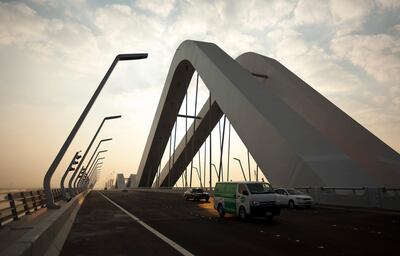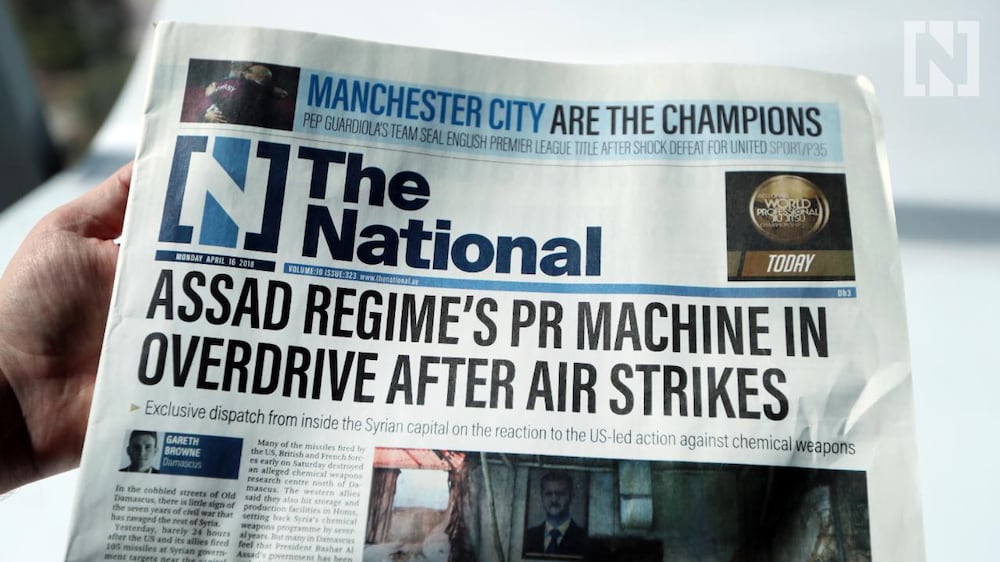There are so many more of us now in April 2018 as compared to 10 years ago – at least another one million living and working in the UAE, making it a place called home.
The country has also grown since the printing presses of The National first rolled in the early hours of April 17, 2008. Just like UAE, they bring something new every day.
Consider Abu Dhabi in the spring of 2008. The skyline was dominated – if that is the right word – by the headquarters of what was then the National Bank of Abu Dhabi on Sheikh Khalifa Street.
At 173 metres, it is less than half the height of the capital’s newest giant, the 382 metre Mohammed bin Rashid tower rising out of the World Trade Centre, which opened in 2013 on the site of the Abu Dhabi souq, a marketplace at the heart of the city going back two centuries.
Some of the city’s most spectacular buildings have sprung up in this time. The Capital Gate, attached to the Abu Dhabi National Exhibition Centre, is certified as the world’s furthest leaning manmade structure by Guinness World Records in 2010.
Zaha Hadid's Sheikh Zayed Bridge still wanted the centre span 10 years ago, before opening in November 2010. That month saw the state visit of Queen Elizabeth, her first since 1979, and the opening by the President of the Sheikh Zayed Bridge and the new motorway bearing the same name.

It opened a whole new gateway to the city, cutting across from the airport past mangroves and azure waters and across Yas and Saadiyat Islands, the new frontier of the city.
What more needs to be said about the Yas Marina Circuit, which brought Formula One for the first time in 2009, or Louvre Abu Dhabi, which opened on Saadiyat only last November.
But the city has evolved in other ways, perhaps less architectural spectacular but which have profoundly influenced the quality of life in Abu Dhabi.
The revival of the Corniche began with the first of three free Womad world music festivals in 2009 with stars such as Rashid Taha and Khaled, and continues with the expansion of the public beach as a place for families to enjoy their leisure time.
The Abu Dhabi Food Festival and the Liwa Date Festival are new additions to the cultural scene during this time, while the International Prize for Arabic Fiction, sometimes dubbed the Arabic Booker, was first awarded in 2008, to the Egyptian writer Bahaa Taher.
It is along the drive to Dubai that other changes over the past 10 years become evident. The road is wider in many places than it was in 2008, to reflect the growth in traffic and the construction of Kizad, the deep-water port and industrial zone in 2010.
Dubai as a city now begins just over the border with its neighbour, with the collection of theme parks that includes Legoland and Bollywood Parks.
It seems an age since the city watched the construction of the final stages and tried to guess the height of what was then called the Burj Dubai, but opened as the 828-metre Burj Khalifa in 2010.
_____________
Read more of our 10-year anniversary coverage here:
SPECIAL REPORT: Chronicling 10 years of change in the UAE
[ The art of institution building ]
[ Cleveland hospital: medical partners bring rude health ]
[ Boom time: a decade when the cranes ruled the UAE's skies ]
Technology has transformed every aspect of life in UAE
____________
We wandered through the new Dubai Mall in November 2008 and wondered if there could ever be enough customers or retailers to fill what was soon billed the most visited building on the planet (oh, and the mall opened a 93,000-square-metre luxury brand expansion last month).
The Metro is so woven into the fabric of the city that it is hard to imagine life without it.
The idea of extending Dubai Creek with a canal through Jumeirah was postponed because of the financial crisis of 2009, revived in 2013 and finally opened in November 2016.
This is a city that is expanding not just upwards, but outwards. Using satellite imagery, the Mohammed bin Rashid Space Centre has calculated Dubai's coastline grew by 6 per cent between 2009 and 2015.
Even the quieter corners of the UAE have experienced dramatic change in the lifetime of this newspaper so far. Al Ain has further cemented its reputation as a cultural centre, with the restoration of Qasr Al Muwaiji, the birthplace of Sheikh Khalifa, in 2015 and the revival of Souq Al Qasr as a focus for local handicrafts and Emirati culture.
Ten years ago the drive west towards Ruwais and Tarif was a nerve-racking game of dodgems involving lumbering trucks and Saudi-driven Land Cruisers.
The old two-lane highway has been transformed to a modern motorway, easing access to getaways such as Sir Bani Yas island, once a wildlife centre established by Sheikh Zayed but welcoming guests as a luxury resort with a safari experience since October 2008.
Drivers along the improved E11 east will also notice something else new on part of their journey. Trains, which have been using the freight route built by Etihad Rail, were established in 2009 and operating services since 2013.
Transport has also been dramatically improved to the Northern Emirates. The Dubai to Fujairah motorway opened in 2011, halving the drive between the two emirates to just an hour.
Three years ago, in an impressive feat of construction that involved cutting through mountains, the Fujairah bypass further improved links to Dubai and Sharjah. In this sense as the UAE grows larger, it also gets smaller.
Ras Al Khaimah has established itself as a centre for tourism since 2008, with resorts such as the Cove Rotana attracting international visitors and the completion of a road that ends at the viewing platform opened last year on Jebel Jais, the country’s tallest mountain. As always, the UAE aims high.








